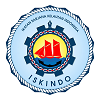MODEL DINAMIK TINGKAT KERENTANAN PANTAI PULAU POTERAN DAN GILI LAWAK KABUPATEN SUMENEP MADURA
Abstract
Pulau Poteran dan Pulau Gili Lawak Kabupaten Sumenep merupakan pulau-pulau kecil yang berada di sebelah barat Pulau Madura dengan kawasan darat dan perairan yang cukup potensial. Tujuan dari penelitian ini adalah pembuatan model dinamik kerentanan pantai pulau-pulau kecil tersebut berdasarkan aspek ekologi, sosial dan ekonomi sebagai upaya awal menetukan perencanaan pengelolaan yang berkelanjutan dan memetakannya. Analisis yang akan dilakukan pada penelitian ini merupakan penetapan variabel-variabel indeks kerentanan pantai pulau-pulau kecil (PPK) dan memodelkan dinamika kerentanan pantai pulau-pulau tersebut. Variabel-variabel tersebut meliputi, (1) Keterpaparan (Exposure), (2) Kepekaan (Sensitivity) dan (3) Daya Adaptasi (Adaptive Capacity). Pengembangan model simulasi dinamis ini bertujuan untuk mempelajari tingkat kerentanan pantai di Pulau Poteran dan Gili Lawak Kecamatan Talango Kabupaten Sumenep didasarkan pada beberapa asumsi, yaitu: (1) model tersebut berada dalam kondisi tetap atau stabil (steady state), (2) model tersebut dianggap suatu sistem yang tertutup (closed system). Parameter kenaikan muka laut rata-rata tiap tahun, tingkat erosi dan kepadatan penduduk merupakan parameter dinamik yang menyebabkan nilai kerentanan tinggi di Pulau Poteran, sedangkan parameter lamun mengakibatkan dimensi daya adaptif diPulau Gili Lawak menjadi lebih tinggi dari dimensi yang lain.Tingkat kerentanan pantai Pulau Poteran dan Gili Lawak berada pada kategori sedang dan berdasarkan model dinamik yang dibuat kedua pulau tersebut akan berada pada tingkat kerentanan sangat tinggi pada tahun ke 3 jika tidak dilakukan peningkatan kapasitas adaptif habitat pesisir.
Kata Kunci: Model Dinamik, Kerentanan, Pulau Kecil
DYNAMICS MODEL OF COASTAL VULNERABILITY OF POTERAN AND GILI LAWAK ISLAND, SUMENEP, MADURA
Poteran and Gili Lawak Island Sumenep Regency is a small islands that located in the west of Madura with potential terrestrial and marine areas. The purpose of this research is the dynamic modeling of coastal vulnerability of small islands are based on ecological, social and economic as an initial effort determine the sustainable management planning and mapping. The analysis will be performed in this study is the determination of variables coastal vulnerability index for small islands and the dynamics models of the vulnerability for coastal islands. These variables include, (1) Exposure, (2) Sensitivity and (3) Adaptive Capacity. The development model of dynamic simulation was done to evaluate the beach vulnerability on the Poteran and Gili Lawak Island at Talango District Sumenep based on several assumptions, they are (1) the model was in a state of permanent or stable (steady state), (2) the model considered a closed system. Mean sea level rise per year, erosion rate and population density are dynamic parameters that causes high of vulnerability value in Pulau Poteran, while the sea-grass parameter on Gili Lawak Island causes the value of adaptive capasity demention is higher than other dimensions.The level of beach vulnerability of Poteran and Gili Lawak Island at middle category and was based on a dynamic model created two islands will be at a very high level of vulnerability in the third yearif not increase the adaptive capacity of coastal habitats.
Keywords: Dynamic Model, Beach Vulnerability, Small Island
Full Text:
PDF (Bahasa Indonesia)References
Adrianto. (2005). Valuasi Ekonomi Sumberdaya Pulau-pulau Kecil: Sebuah Konsepsi Ecological-Economics. In Working Paper Kebijakan Pengelolaan Perikanan dan Wilayah Pesisir tahun 2005. Adrianto L (Eds). Pusat Kajian Sumberdaya Pesisir dan Lautan IPB.Bogor. Part-7.
Doukakis, E. (2005). Coastal vulnerability and risk parameter. European Water, 11(12).
McClanahan, T. R., Cinner, J. E., Maina, J., Graham, N. A. J., Daw, T. M., Stead, S. M., Wamukota, A., Brown, K., Ateweberhan, M., Venus, V., & Polunin, N. V. C. (2008). Conservation action in a changing climate. Conservation Letter, 1, 53-59.
Mimura, N. (1999). Vulnerability of island countries in the South Pacific to sea level rise and climate change. Climate Research, 12, 137-143.
Polsky, C., Neff, R., & Yarnal, B. (2007). Building Comparable Global Change Vulnerability Assessments: The Vulnerabilitys Coping Diagram. Global Environmental Change, 17, 472-485.
Pratt, C. R., Kaly, U. L., & Mitchell, J. (2004). Manual: How to use the Environmental Vulnerability Index (EVI). SOPAC Technical Report 383: 60. United Nations Environment Program (UNEP). South Pacific Applied Geoscience Commission (SOPAC).
Rao, K. N, Subra, Elu, P., Rao, T. V., Malini, B. H., Ratheesh, R., Bhattacharya, S., Rajawat, A. S., & Ajai. (2008). Sea level rise and coastal vulnerability: an assessment of Andhara Pradesh Coast, India through remote sensing and GIS. J. Coast. Conser., 12.
Tahir, A., Mennofatria, B., Susilo, B. D., & Jaya, I. (2009). Indeks Keretanan Pulau-pulau Kecil: Kasus Pulau Barrang Lompo Makasar. Jurnal Ilmu Kelautan, 14(4), 8-13.
Tahir, A. (2010). Formulasi Indeks Kerentanan Lingkungan Pulau-Pulau Kecil Kasus Pulau Kasu-Kota Batam, Pulau Barrang Lompo-Kota Makasar, dan Pulau Saonek-Kabupaten Raja Ampat. [Disertasi] Institut Pertanian Bogor. [Tidak Dipublikasikan].
Victor, S., Neth, L., Golbuu, Y., Wolanski, E., & Richmond, R. H. (2007). Sedimentation in mangroves and coral reefs in a wet tropical island, Pohnpei, Micronesia. Estuarine, Coastal and Shelf Science, 66, 409-416.
DOI: https://doi.org/10.21107/jk.v10i1.2427
Refbacks
- There are currently no refbacks.

This work is licensed under a Creative Commons Attribution 4.0 International License.

Jurnal Kelautan by Program Studi Ilmu Kelautan is licensed under a Creative Commons Attribution 4.0 International License.
Published by: Department of Marine Sciences, Trunojoyo University of Madura













